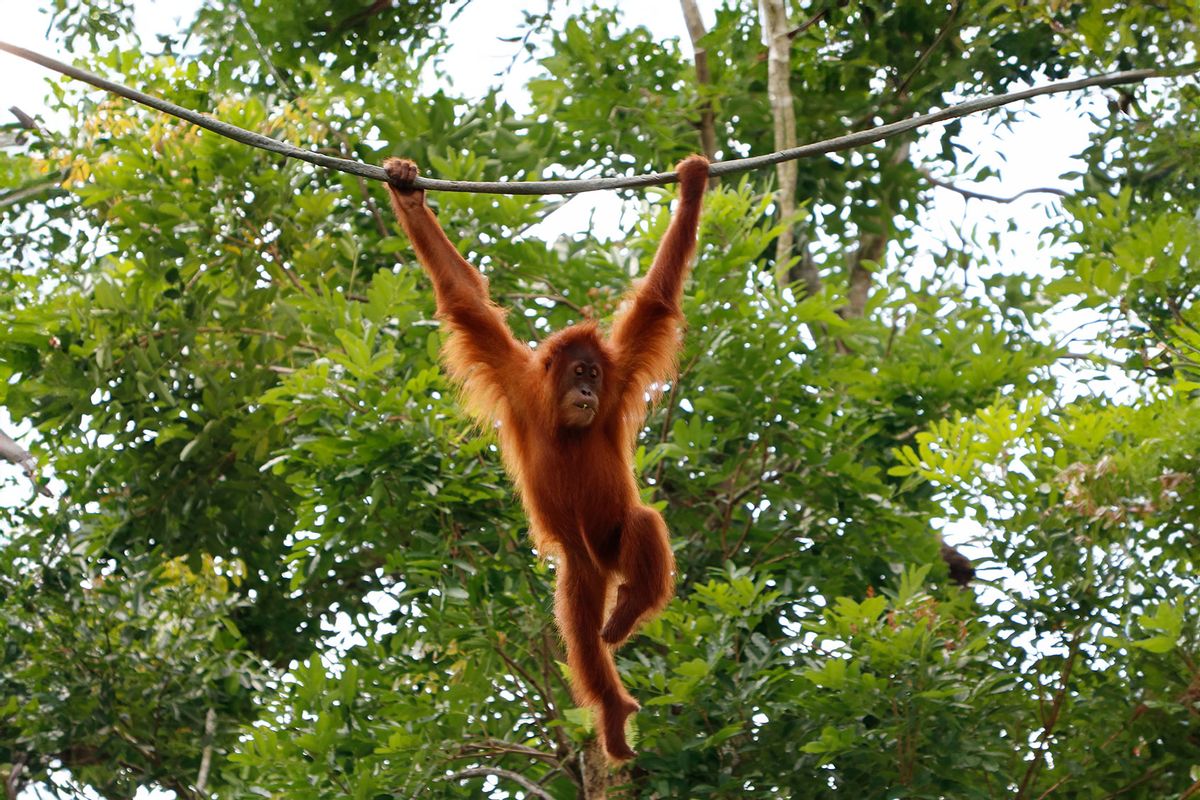Wendy Erb has spent countless hours studying orangutans in Borneo's tropical peatland forests in order to learn how male Bornean orangutans (Pongo pygmaeus wurmbii) communicate. While doing so, she discovered one undeniable advantage of understanding orangutan language: When the males decide to show off their strength by uprooting nearby trees, nearby scientists need to be careful to not get smooshed.
"I often wonder which of these snag crashes are directed at neighboring orangutans and which of them might be a message for us to give these guys some space!"
"Orangutans have extraordinary strength and big males have a penchant for finding standing dead trees and shaking, pushing or pulling them until they topple in a tremendous (and impressive) crash," Erb told Salon. "Orangutan researchers thus need to stay quite vigilant while these giants move through the canopy, as these falling trees can present a real hazard to us mortal bipeds. Though sometimes we fail to note a nearby dead tree when the males are making their evening nests, these males never miss a chance to show off their feats of strength."
Because Erb and her colleagues don't know orangutanese, so to speak, they cannot know if these males ever attempted to warn them while they figuratively and literally flexed their muscles. Yet perhaps one day they will, because in a recent study published today in the journal PeerJ Life & Environment, both the Cornell University tropical field and behavioral ecologist and her peers reveal orangutans have tremendous vocal complexity while calling to each other from long distances.
The researchers set out to learn how many different sound types exist within orangutan long calls, how can they be distinguished and the extent to which they are graded. They observed the calls of 13 male orangutans and were careful not to disturb them. Armed with audio analytic techniques including machine learning, they found that orangutan long calls include only two to four loosely differentiated sound types. Within those sound types, the orangutans produce a divers spectrum of intermediate types which yield sounds capable of being combined into various sequences within a single vocalization.
We need your help to stay independent
This study confirms orangutans possess sophisticated communication abilities, putting them on par with other primates like chimpanzees. At the same time, this paper only scratches the surface in terms of grasping the full intricacy of orangutan communications.
"While vocal complexity is an important concept in animal communication – thought to be shaped by animals’ social and physical environments – we are lacking a unifying framework for quantifying complexity," Erb said. "For species like orangutans, whose sounds fall along a ‘graded’ continuum, we don’t yet know how to interpret the apparently low number of ‘discrete’ sounds; however, we are fairly confident there is much complexity still to unpack in this great ape’s vocal system."
Want more health and science stories in your inbox? Subscribe to Salon's weekly newsletter Lab Notes.
"We still have a lot of work ahead to unpack this complexity and its significance in the evolution of animal communication systems."
By learning more about orangutan vocalizations, scientists could ultimately better understand how humans learned to speak. Every species develops its vocal complexity because of evolutionary influences such as sexual selection, the details of their habitats, their specific social structures and pressure from predators. For example, the authors write, "black-capped chickadee (Poecile atricapillus) groups, individuals flexibly increase the diversity of note types when they are in larger groups, presumably increasing the number of potential messages that can be conveyed."
Humans are able to create far more elaborate sounds that any other primate species, but there is still a direct link between how more primitive primates developed those abilities and how we did. For that to happen, however, scientists will first need to comprehend how the more "graded" vocalizations employed by animals like orangutans manage to effectively convey meaning.
"Our study points to the need to develop a comparative framework for quantifying and comparing complexity within and across species with such graded repertoires," Erb said. "We still have a lot of work ahead to unpack this complexity and its significance in the evolution of animal communication systems."
Researchers dream of a future in which humans can casually converse with orangutans, chimpanzees and other primates as easily as we do among each other. That day is no doubt very far in the future — but it will certainly be useful for future scientists like Erb, at least when they want to avoid being unintentional casualties of orangutan machismo.
"In the dark, it's much harder to assess which way the tree is going to fall, so we were quite lucky to have made it through these heart-pounding wake-up calls unscathed," Erb said. "I often wonder which of these snag crashes are directed at neighboring orangutans and which of them might be a message for us to give these guys some space!"



Shares